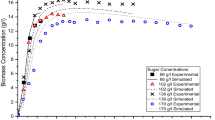Abstract
An industrial process is profitable when its individual unit operations are efficient and thus, this work shows a guideline for designing efficient fermentation-industrial processes for agave distilled production based on a sequential approach of optimization, beginning in the laboratory and followed by the adjustment of the variable values using the evolutionary operation method for successful process scaling. The results at the laboratory showed that a starter inoculum containing a 5 × 106 cells/mL mixture of Kluyveromyces marxianus, Clavispora lusitaniae, and Kluyveromyces marxianus var. drosophilarum strains in a bioreactor containing agave syrup with 120 g/L fermented sugar, processed at a constant temperature of 33 °C and 1.0 VVM aeration for 1.6 h, led to a fermented product with a 4.18% (v/v) alcohol content after 72 h of processing time. The scale-up process results showed that the best operating conditions at the pilot-plant level were a temperature of 35 °C and aeration at 1.0 VVM for 1.2 h, which led to a fermented product with a 4.22% (v/v) total alcohol content after 72 h of processing time. These represent similar performance values for both production processes, but each one worked with their specific values of process variables, which demonstrates that each level of production had its own specific values for process variables. The volatile compound analysis shows that both distilled products contained a similar profile of volatile components that provide fruity and ethereal aromatic notes pleasant to the palate. Therefore, the process design for agave spirit production at the semi-industrial level was successfully achieved.


Similar content being viewed by others
References
Mandenius CF, Brundin A (2008) Biocatalysts and bioreactor design. Bioprocess optimization using design-of- experiments methodology. Biotechnol Prog 24(6):1191–1203. https://doi.org/10.1002/btpr.67
Navarrete-Bolaños JL (2012) Improving traditional fermented beverages: how to evolve from spontaneous to directed fermentation. Review Eng Life Sci 12(4):410–418. https://doi.org/10.1002/elsc.201100128
Navarrete-Bolaños JL, Téllez-Martínez MG, Miranda-López R, Jiménez-Islas H (2017) An experimental strategy validated to design cost-effective culture media based on response surface methodology. Prep Biochem Biotechnol 47(6):578–588. https://doi.org/10.1080/10826068.2017.1280825
Navarrete-Bolaños JL, González-Torres I, Vargas-Bermúdez VH, Jiménez-Islas H (2020) A biotechnological insight to recycle waste: analyzing the spontaneous fermentation of shrimp waste to design the hydrolysis process of chitin into n-acetylglucosamine. Rev Mex Ing Quím 19(1):263–274. https://doi.org/10.24275/rmiq/Bio544
García-Aguirre M, Sáenz-Álvaro VA, Rodríguez-Soto MA, Vicente-Magueyal FJ, Botello-Álvarez E, Jiménez-Islas H et al (2009) A strategy for biotechnological process design applied to the enzymatic hydrolysis of agave fructo-oligosaccharides to obtain fructose-rich syrups. J Agric Food Chem 57:10205–10210. https://doi.org/10.1021/jf902855q
Tervasmäkia P, Latva-Kokkob M, Taskilaa S, Tanskanena J (2018) Effect of oxygen transfer on yeast growth—growth kinetic and reactor model to estimate scale-up effects in bioreactors. Food Bioprod Process 111:129–140. https://doi.org/10.1016/j.fbp.2018.08.004
Delvigne F, Takors R, Mudde R, van Gulik W, Noorman H (2017) Bioprocess scale-up/down as integrative enabling technology: from fluid mechanics to systems biology and beyond. Microb Biotechnol 10(5):1267–1274. https://doi.org/10.1111/1751-7915.12803
Ju LK, Chase GG (1992) Improved scale-up strategies of bioreactors. Bioprocess Eng 8:49–53. https://doi.org/10.1007/BF00369263
Schmidt FR (2005) Optimization and scale up of industrial fermentation processes: mini-review. Appl Microbiol Biotechnol 68:425–435
Pia-Koller A, Wolf L, Brück T, Weuster-Botz D (2018) Studies on the scale-up of biomass production with Scenedesmus spp. in flat-plate gas-lift photobioreactors. Bioprocess Biosyst Eng 41(2):213–220. https://doi.org/10.1007/s00449-017-1859-y
Kumar S, Katiyar N, Ingle P, Negi S (2011) Use of evolutionary operation (EVOP) factorial design technique to develop a bioprocess using grease waste as a substrate for lipase production. Bioresour Technol 102(7):4909–4912. https://doi.org/10.1016/j.biortech.2010.12.114
Box GEP (1957) Evolutionary operation: a method for increasing industrial productivity. J R Stat Soc Ser C 6(2):81–101. https://doi.org/10.2307/2985505
Montgomery DC (2005) Response surface methods and designs. In: Montgomery DC (ed) Design and analysis of experiments, 6th edn. Wiley, NY, pp 405–463
Miller G (1959) Use of dinitrosalicylic acid reagent for determination of reducing sugar. Anal Chem 31:426–428. https://doi.org/10.1021/ac60147a030
Caputi A, UedaBrown MT (1968) Spectrophotometric determination of ethanol in wine. Am J Enol Vitic 19:160–165
Molina-Guerrero JA, Botello-Álvarez JE, Estrada-Baltazar A, Navarrete-Bolaños JL, Jiménez-Islas H, Cárdenas-Manríquez M, Rico-Martínez R (2007) Volatile components in mezcal. Rev Mex Ing Quím 6:41–50. http://rmiq.org/ojs311/index.php/rmiq/article/view/1843
Benn SM, Peppard TL (1996) Characterization of tequila flavor by instrumental and sensory analysis. J Agric Food Chem 44:557–566. https://doi.org/10.1021/jf9504172
de León-Rodríguez A, González-Hernández L, de la Barba Rosa A, Escalante-Minakata P, López M (2006) Characterization of volatile compounds of mezcal, an ethnic alcoholic beverage obtained from Agave salmiana. J Agric Food Chem 54:1337–1341. https://doi.org/10.1021/jf052154+
Acknowledgements
The authors thank Tecnológico Nacional de México and Consejo de Ciencia y Tecnología del Estado de Guanajuato by financial support.
Author information
Authors and Affiliations
Contributions
All authors contributed to the conception, performance, and design of the studies, as well as the interpretation of the results, the critical revision, and final approval of the manuscript. OSJ, HCM, and FJVM performed the experiments and analyzed the experimental data. HJI, and JLNB, were the intellectual authors and wrote the manuscript.
Corresponding author
Ethics declarations
Conflict of interest
There is no known actual or potential conflict of interest including any financial, personal or other relationships with other people or organizations associated with this work.
Additional information
Publisher's Note
Springer Nature remains neutral with regard to jurisdictional claims in published maps and institutional affiliations.
Supplementary Information
Below is the link to the electronic supplementary material.
Rights and permissions
About this article
Cite this article
Navarrete-Bolaños, J.L., Serrato-Joya, O., Chávez-Mireles, H. et al. A validated strategy to design efficient fermentation-industrial processes: agave spirit production. Bioprocess Biosyst Eng 44, 2245–2255 (2021). https://doi.org/10.1007/s00449-021-02600-z
Received:
Accepted:
Published:
Issue Date:
DOI: https://doi.org/10.1007/s00449-021-02600-z




